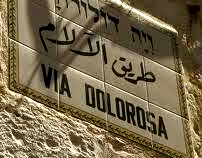
Meaning "the way of suffering" in Latin, via dolorosa is a religious practice in many older European churches in which devotees follow a path set out with different 'stations of the cross' that recall—and that encourages the devotees to reflect on—the journey of Jesus from his betrayal in the Garden of Gethsemane to his cruxification and burial.

The most famous via dolorosa is, no doubt, the one in Jerusalem that begins just inside Lion's Gate on the eastern side of the Old City and ends inside the Church of the Holy Sepulchre. Though still thought by many ordinary Christians to be the actual path Jesus took, it is beyond any doubt that the Via Dolorosa in Jerusalem could not have been so. The site of the first two stations just inside the Lion's Gate, e.g., was occupied by a pool in the time of Jesus called 'the pool of Israel.' The Ecce Homo, the site where Pontius Pilate was supposed to have presented Jesus, wearing the crown of thorns and purple robe, to the crowd, (Jn 19:5) was then occupied by a rock-cut pool called the Struthion Pool (the Sparrow Pool), the remains of parts of which can still be seen in the basement of the Franciscan Chapel of the Flagellation on the northern side of the street. The pool was later (possibly in the time of Emperor Hadrian) paved over to become the Lithostrothon (also visible in the same basement). The course of the Via Dolorosa had, in fact, changed several times over the centuries; the present one being fixed only in the 18th Cent, and a number of the stations given their current position in the 19th. The Via Dolorosa is, therefore, "defined by faith, not by history" (J. Murphy-O'Connor).

©ALBERITH